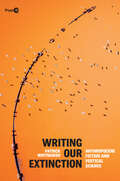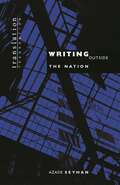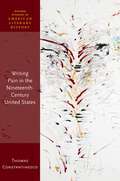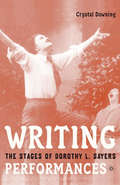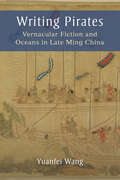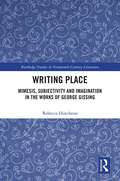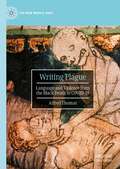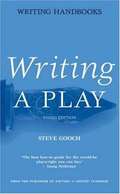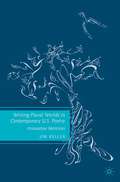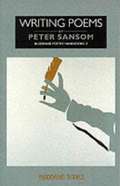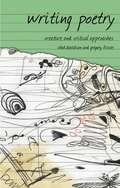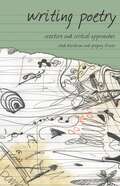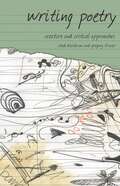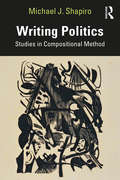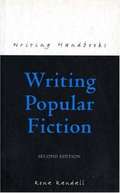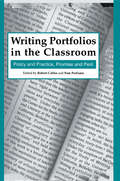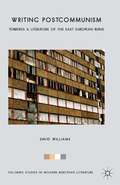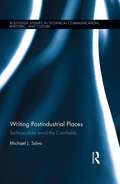- Table View
- List View
Writing Our Extinction: Anthropocene Fiction and Vertical Science (Post*45)
by Patrick WhitmarshMid-twentieth-century developments in science and technology produced new understandings and images of the planet that circulated the globe, giving rise to a modern ecological consciousness; but they also contributed to accelerating crises in the global environment, including climate change, pollution, and waste. In this new work, Patrick Whitmarsh analyzes postwar narrative fictions that describe, depict, or express the earth from above (the aerial) and below (the subterranean), revealing the ways that literature has engaged this history of vertical science and linked it to increasing environmental precarity, up to and including the extinction of humankind. Whitmarsh examines works by writers such as Don DeLillo, Karen Tei Yamashita, Reza Negarestani, and Colson Whitehead alongside postwar scientific programs including the Space Race, atmospheric and underground nuclear testing, and geological expeditions such as Project Mohole (which attempted to drill to the earth's mantle). As Whitmarsh argues, by focusing readers' attention on the fragility of postwar life through a vertical lens, Anthropocene fiction highlights the interconnections between human behavior and planetary change. These fictions situate industrial history within the much longer narrative of geological time and reframe scientific progress as a story through which humankind writes itself out of existence.
Writing Our Extinction: Anthropocene Fiction and Vertical Science (Post*45)
by Patrick WhitmarshMid-twentieth-century developments in science and technology produced new understandings and images of the planet that circulated the globe, giving rise to a modern ecological consciousness; but they also contributed to accelerating crises in the global environment, including climate change, pollution, and waste. In this new work, Patrick Whitmarsh analyzes postwar narrative fictions that describe, depict, or express the earth from above (the aerial) and below (the subterranean), revealing the ways that literature has engaged this history of vertical science and linked it to increasing environmental precarity, up to and including the extinction of humankind. Whitmarsh examines works by writers such as Don DeLillo, Karen Tei Yamashita, Reza Negarestani, and Colson Whitehead alongside postwar scientific programs including the Space Race, atmospheric and underground nuclear testing, and geological expeditions such as Project Mohole (which attempted to drill to the earth's mantle). As Whitmarsh argues, by focusing readers' attention on the fragility of postwar life through a vertical lens, Anthropocene fiction highlights the interconnections between human behavior and planetary change. These fictions situate industrial history within the much longer narrative of geological time and reframe scientific progress as a story through which humankind writes itself out of existence.
Writing Outside the Nation
by Azade SeyhanSome of the most innovative writers of contemporary literature are writing in diaspora in their second or third language. Here Azade Seyhan describes the domain of transnational poetics they inhabit. She begins by examining the works of selected bilingual and bicultural writers of the United States (including Oscar Hijuelos, Maxine Hong Kingston, and Eva Hoffman) and Germany (Libuse Moníková, Rafik Schami, and E. S. Özdamar, among others), developing a new framework for understanding the relationship between displacement, memory, and language. Considering themes of loss, witness, translation, identity, and exclusion, Seyhan interprets diasporic literatures as condensed archives of cultural and linguistic memory that give integrity and coherence to pasts ruptured by migration. The book next compares works by contemporary Chicana and Turkish-German women writers as innovative and sovereign literary voices within the larger national cultures of the United States and Germany. Seyhan identifies in American multiculturalism critical clues for analyzing new cultural formations in Europe and maintains that Germany's cultural transformation suggests new ways of reading the American literary mosaic. Her approach, however, extends well beyond these two literatures. She creates a critical map of a "third geography," where a transnational, multilingual literary movement is gathering momentum. Writing Outside the Nation both contributes to and departs from postcolonial studies in that it focuses specifically on transnational writers working outside of their "mother tongue" and compares American and German diasporic literatures within a sophisticated conceptual framework. It illustrates how literature's symbolic economy can reclaim lost personal and national histories, as well as connect disparate and distant cultural traditions.
Writing Outside the Nation (Translation/Transnation #31)
by Azade SeyhanSome of the most innovative writers of contemporary literature are writing in diaspora in their second or third language. Here Azade Seyhan describes the domain of transnational poetics they inhabit. She begins by examining the works of selected bilingual and bicultural writers of the United States (including Oscar Hijuelos, Maxine Hong Kingston, and Eva Hoffman) and Germany (Libuse Moníková, Rafik Schami, and E. S. Özdamar, among others), developing a new framework for understanding the relationship between displacement, memory, and language. Considering themes of loss, witness, translation, identity, and exclusion, Seyhan interprets diasporic literatures as condensed archives of cultural and linguistic memory that give integrity and coherence to pasts ruptured by migration. The book next compares works by contemporary Chicana and Turkish-German women writers as innovative and sovereign literary voices within the larger national cultures of the United States and Germany. Seyhan identifies in American multiculturalism critical clues for analyzing new cultural formations in Europe and maintains that Germany's cultural transformation suggests new ways of reading the American literary mosaic. Her approach, however, extends well beyond these two literatures. She creates a critical map of a "third geography," where a transnational, multilingual literary movement is gathering momentum. Writing Outside the Nation both contributes to and departs from postcolonial studies in that it focuses specifically on transnational writers working outside of their "mother tongue" and compares American and German diasporic literatures within a sophisticated conceptual framework. It illustrates how literature's symbolic economy can reclaim lost personal and national histories, as well as connect disparate and distant cultural traditions.
Writing Pain in the Nineteenth-Century United States (Oxford Studies in American Literary History)
by Thomas ConstantinescoWriting Pain in the Nineteenth-Century United States examines how pain is represented in a range of literary texts and genres from the nineteenth-century US. It considers the aesthetic, philosophical, and ethical implications of pain across the works of Ralph Waldo Emerson, Harriet Jacobs, Emily Dickinson, Henry James, Elizabeth Stuart Phelps, and Alice James, as the national culture of pain progressively transformed in the wake of the invention of anesthesia. Through examining the work of nineteenth-century writers, Constantinesco argues that pain, while undeniably destructive, also generates language and identities, and demonstrates how literature participates in theorizing the problems of mind and body that undergird the deep chasms of selfhood, sociality, gender, and race of a formative period in American history. Writing Pain in the Nineteenth-Century United States considers first Emerson's philosophy of compensation, which promises to convert pain into gain. It also explores the limitations of this model, showing how Jacobs contests the division of body and mind that underwrites it and how Dickinson challenges its alleged universalism by foregrounding the unshareability of pain as a paradoxical measure of togetherness. It then investigates the concurrent economies of affects in which pain was implicated during and after the Civil War and argues, through the example of James and Phelps, for queer sociality as a response to the heteronormative violence of sentimentalism. The last chapter on Alice James extends the critique of sentimental sympathy while returning to the book's premise that pain is generative and the site of thought. By linking literary formalism with individual and social formation, Writing Pain in the Nineteenth-Century United States eventually claims close reading as a method to recover the theoretical work of literature.
Writing Pain in the Nineteenth-Century United States (Oxford Studies in American Literary History)
by Thomas ConstantinescoWriting Pain in the Nineteenth-Century United States examines how pain is represented in a range of literary texts and genres from the nineteenth-century US. It considers the aesthetic, philosophical, and ethical implications of pain across the works of Ralph Waldo Emerson, Harriet Jacobs, Emily Dickinson, Henry James, Elizabeth Stuart Phelps, and Alice James, as the national culture of pain progressively transformed in the wake of the invention of anesthesia. Through examining the work of nineteenth-century writers, Constantinesco argues that pain, while undeniably destructive, also generates language and identities, and demonstrates how literature participates in theorizing the problems of mind and body that undergird the deep chasms of selfhood, sociality, gender, and race of a formative period in American history. Writing Pain in the Nineteenth-Century United States considers first Emerson's philosophy of compensation, which promises to convert pain into gain. It also explores the limitations of this model, showing how Jacobs contests the division of body and mind that underwrites it and how Dickinson challenges its alleged universalism by foregrounding the unshareability of pain as a paradoxical measure of togetherness. It then investigates the concurrent economies of affects in which pain was implicated during and after the Civil War and argues, through the example of James and Phelps, for queer sociality as a response to the heteronormative violence of sentimentalism. The last chapter on Alice James extends the critique of sentimental sympathy while returning to the book's premise that pain is generative and the site of thought. By linking literary formalism with individual and social formation, Writing Pain in the Nineteenth-Century United States eventually claims close reading as a method to recover the theoretical work of literature.
Writing Performances: The Stages of Dorothy L. Sayers
by C. DowningAfter Dorothy L. Sayers became famous for her fictional sleuth, Lord Peter Wimsey, she began investigating the mysteries of Anglo-Catholic Christianity, writing plays for both stage and radio. However, because her modernist contemporaries disdained both best-sellers and religious fiction, Sayers has been largely overlooked by the academy. Writing Performances is the first work to position Sayers' diverse writings within the critical climate of high modernism. Employing exuberant illustrations from Sayers' detective fiction to make theoretical issues accessible, the book employs insights from performance theory to argue that Sayers, though a popularizer, presciently anticipated the postmodern ironizing of Enlightenment rationality and scientific objectivity.
Writing Pirates: Vernacular Fiction and Oceans in Late Ming China
by Yuanfei WangIn Writing Pirates, Yuanfei Wang connects Chinese literary production to emerging discourses of pirates and the sea. In the late Ming dynasty, so-called “Japanese pirates” raided southeast coastal China. Hideyoshi invaded Korea. Europeans sailed for overseas territories, and Chinese maritime merchants and emigrants founded diaspora communities in Southeast Asia. Travel writings, histories, and fiction of the period jointly narrate pirates and China’s Orient in maritime Asia. Wang shows that the late Ming discourses of pirates and the sea were fluid, ambivalent, and dialogical; they simultaneously entailed imperialistic and personal narratives of the “other”: foreigners, renegades, migrants, and marginalized authors. At the center of the discourses, early modern concepts of empire, race, and authenticity were intensively negotiated. Connecting late Ming literature to the global maritime world, Writing Pirates expands current discussions of Chinese diaspora and debates on Sinophone language and identity.
Writing Place: Mimesis, Subjectivity and Imagination in the Works of George Gissing (Routledge Studies in Nineteenth Century Literature)
by Rebecca HutcheonExploring a hitherto neglected field, Writing Place: Mimesis, Subjectivity and Imagination in the Works of George Gissing is the first monograph to consider the works of George Gissing (1857-1903) in light of the ‘spatial turn’. By exploring how objectivity and subjectivity interact in his work, the book asks: what are the risks of looking for the ‘real’ in Gissing’s places? How does the inherent heterogeneity of Gissing’s observation influence the textual recapitulation of place? In addition to examining canonical texts such as The Nether World (1889), New Grub Street (1891), and The Private Papers of Henry Ryecroft (1901), the book analyses the lesser-known novels, short stories, journalism and personal writings of Gissing, in the context of modern spatial studies. The book challenges previously biographical and London-centric accounts of Gissing’s representation of space and place by re-examining seemingly innate contemporaneous geographical demarcations such as the north and the south, the city, suburb, and country, Europe and the world, and re-reading Gissing’s places in the contexts of industrialism, ruralism, the city in literature, and travel writing. Through sustained attention to the ambiguities and contradictions rooted in the form and content of his writing, the book concludes that, ultimately, Gissing’s novels undermine spatial dichotomies by emphasising and celebrating the incongruity of seeming certainties
Writing Place: Mimesis, Subjectivity and Imagination in the Works of George Gissing (Routledge Studies in Nineteenth Century Literature)
by Rebecca HutcheonExploring a hitherto neglected field, Writing Place: Mimesis, Subjectivity and Imagination in the Works of George Gissing is the first monograph to consider the works of George Gissing (1857-1903) in light of the ‘spatial turn’. By exploring how objectivity and subjectivity interact in his work, the book asks: what are the risks of looking for the ‘real’ in Gissing’s places? How does the inherent heterogeneity of Gissing’s observation influence the textual recapitulation of place? In addition to examining canonical texts such as The Nether World (1889), New Grub Street (1891), and The Private Papers of Henry Ryecroft (1901), the book analyses the lesser-known novels, short stories, journalism and personal writings of Gissing, in the context of modern spatial studies. The book challenges previously biographical and London-centric accounts of Gissing’s representation of space and place by re-examining seemingly innate contemporaneous geographical demarcations such as the north and the south, the city, suburb, and country, Europe and the world, and re-reading Gissing’s places in the contexts of industrialism, ruralism, the city in literature, and travel writing. Through sustained attention to the ambiguities and contradictions rooted in the form and content of his writing, the book concludes that, ultimately, Gissing’s novels undermine spatial dichotomies by emphasising and celebrating the incongruity of seeming certainties
Writing Plague: Language and Violence from the Black Death to COVID-19 (The New Middle Ages)
by Alfred ThomasWriting Plague: Language and Violence from the Black Death to COVID-19 brings a holistic and comparative perspective to “plague writing” from the later Middle Ages to the twenty-first century. It argues that while the human “hardware” has changed enormously between the medieval past and the present (urbanization, technology, mass warfare, and advances in medical science), the human “software” (emotional and psychological reactions to the shock of pandemic) has remained remarkably similar across time. Through close readings of works by medieval writers like Guillaume de Machaut, Giovanni Boccaccio, and Geoffrey Chaucer in the fourteenth century, select plays by Shakespeare, and modern “plague” fiction and film, Alfred Thomas convincingly demonstrates psychological continuities between the Black Death and COVID-19. In showing how in times of plague human beings repress their fears and fantasies and displace them onto the threatening “other,” Thomas highlights the danger of scapegoating vulnerable minority groups such as Asian Americans and Jews in today’s America. This wide-ranging study will thus be of interest not only to medievalists but also to students of modernity as well as the general reader.
Writing A Play (PDF)
by Steve GoochThis book is a practical guide to the process of play-writing, from the original inspiration through plotting, structuring and characterisation to the successful realisation of the idea. This revised edition includes a new chapter covering stage realism.
Writing Plural Worlds in Contemporary U.S. Poetry: Innovative Identities
by J. KellerThis book reveals how poets within the U.S. multi-ethnic avant-garde give up the goal of narrating one comprehensive, rooted view of cultural reality in favour of constructing coherent accounts of relational, local selves and worlds.
Writing Poems (PDF)
by Peter SansomDrawing on his extensive experience of poetry workshops and courses, Peter Sansom shows would-be poets how to write better, how to write authentically, and how to say genuinely what is to be said. He illustrates his book with many useful examples, covering the areas of writing techniques and procedures and drafting.
Writing Poetry: Creative and Critical Approaches (PDF)
by Chad Davidson Greg FraserWriting Poetry combines an accessible introduction to the essential elements of the craft, with a critical awareness of its historical, ideological and aesthetic underpinnings. The authors argue that separating the making of poems from critical thinking about them is a false divide and encourage students to delve deeper into their work by becoming accomplished critics and active readers of poetic texts. The book presents a range of strategies and practical exercises to help initiate and sustain the process of making poems, while also demonstrating the value of activities such as memorizing poems, reading and writing about poetic traditions, developing manifestos and statements of aesthetics, and composing self-reviews which place poems within critical context. The first book designed specifically to meet the needs of students studying poetry writing in the context of criticism and literary study, this is an invaluable guide to all aspiring poets.
Writing Poetry: Creative and Critical Approaches (Approaches to Writing)
by Chad Davidson Gregory FraserWriting Poetry combines an accessible introduction to the essential elements of the craft, with a critical awareness of its underpinnings. The authors argue that separating the making of poems from critical thinking about them is a false divide and encourage students to become accomplished critics and active readers of poetic texts.
Writing Poetry: Creative and Critical Approaches (Approaches to Writing)
by Chad Davidson Gregory FraserWriting Poetry combines an accessible introduction to the essential elements of the craft, with a critical awareness of its underpinnings. The authors argue that separating the making of poems from critical thinking about them is a false divide and encourage students to become accomplished critics and active readers of poetic texts.
Writing Poetry (PDF)
by Bill Herbert W. N. HerbertThis volume presents new versions of key chapters from the recent Routledge/Open University textbook, Creative Writing: A Workbook with Readings for writers who are specialising in writing poetry. It offers the novice writer engaging and creative activities, making use of insightful, relevant readings from the work of well-known authors to illustrate the techniques presented. Using his experience and expertise as a teacher as well as a poet, Bill Herbert guides aspiring writers through such key writing skills as: drafting voice imagery rhyme form theme. The volume is further updated to include never-before published dialogues with prominent poets such as Vicki Feaver, Gillian Allnutt, Kathleen Jamie, Linda France, Douglas Dunn, Sean O'Brien and Jo Shapcott. Concise and practical, Writing Poetry offers an inspirational guide to the methods and techniques of this challenging and rewarding genre and is a must-read for aspiring poets.
Writing Politics: Studies in Compositional Method
by Michael J ShapiroWriting Politics is a methods book designed to instruct on politically focused literary inquiry. Exploring the political sensibilities that arise from the way literary fiction re-textualizes historical periods and events, the book features a series of violence-themed inquiries that emphasize forms of writing as the vehicles for politically attuned historiography. Each investigation treats the way the literary genre, within historiographic metafiction, enables political inquiry. It’s a form of writing that inter-articulates history and fiction to rework a textual past and unsettle dominant understandings of events and situations. Central to the diverse chapters are fictional treatments of authoritarian, fascist, or zealous mentalities. Featured, for example, are Radovan Karadzic (the architect of the Bosnian genocide), Reinhard Heydrich (the architect of the Holocaust’s "final solution"), and the Trotsky assassin Ramon Mercader. Michael J. Shapiro has produced another original and sophisticated bookshelf staple; the only contemporary investigation in Political Studies that instructs on method in this way.
Writing Politics: Studies in Compositional Method
by Michael J ShapiroWriting Politics is a methods book designed to instruct on politically focused literary inquiry. Exploring the political sensibilities that arise from the way literary fiction re-textualizes historical periods and events, the book features a series of violence-themed inquiries that emphasize forms of writing as the vehicles for politically attuned historiography. Each investigation treats the way the literary genre, within historiographic metafiction, enables political inquiry. It’s a form of writing that inter-articulates history and fiction to rework a textual past and unsettle dominant understandings of events and situations. Central to the diverse chapters are fictional treatments of authoritarian, fascist, or zealous mentalities. Featured, for example, are Radovan Karadzic (the architect of the Bosnian genocide), Reinhard Heydrich (the architect of the Holocaust’s "final solution"), and the Trotsky assassin Ramon Mercader. Michael J. Shapiro has produced another original and sophisticated bookshelf staple; the only contemporary investigation in Political Studies that instructs on method in this way.
Writing Popular Fiction (PDF)
by Rona RandallPopular fiction includes romance, thrillers and fantasy but this book covers how to write all types of popular fiction. The guide explains how to start out, how to avoid pitfalls in writing and how to get your work published.
Writing Portfolios in the Classroom: Policy and Practice, Promise and Peril
by Robert C. Calfee Pamela PerfumoThis volume presents chapters by researchers, practitioners, and policymakers who study the impact of classroom portfolios in the assessment of writing achievement by elementary and middle grade students. The focus throughout the volume is on the tension between classroom assessment and externally mandated testing. It presents the efforts of researchers, practitioners, and policymakers to understand the impact of classroom portfolios for the assessment of writing achievement by elementary and middle grade students. Under the auspices of the Center for the Study of Writing, the editors conducted a national survey of exemplary portfolio projects, arranged for a series of "video visits," and held several working conferences. The result of this work is a broad-ranging tale: the aspirations of teachers and administrators to move the machinery of schooling in the direction of more authentic and engaging tasks, the puzzlement of students when they realize that the assignments are real and that the teacher may not have a "right answer" in mind, and the tensions between ivory-tower ideas and everyday classroom practice. Divided into four sections, this research volume: * provides a historical perspective, develops the conceptual framework that serves as a background for many activities described throughout, and discusses numerous practical issues that confront today's researchers and practitioners; * views the phenomenon of writing portfolios through a variety of broadview lenses such as teacher enthusiasm, student reflection, assessment tension, the portfolio as metaphor, and the locus of control; * conveys important conceptual issues with a balance toward pragmatics; and * offers unique insights from the perspective of one individual who serves as scholar, researcher, and teacher.
Writing Portfolios in the Classroom: Policy and Practice, Promise and Peril
by Robert Calfee Pamela PerfumoThis volume presents chapters by researchers, practitioners, and policymakers who study the impact of classroom portfolios in the assessment of writing achievement by elementary and middle grade students. The focus throughout the volume is on the tension between classroom assessment and externally mandated testing. It presents the efforts of researchers, practitioners, and policymakers to understand the impact of classroom portfolios for the assessment of writing achievement by elementary and middle grade students. Under the auspices of the Center for the Study of Writing, the editors conducted a national survey of exemplary portfolio projects, arranged for a series of "video visits," and held several working conferences. The result of this work is a broad-ranging tale: the aspirations of teachers and administrators to move the machinery of schooling in the direction of more authentic and engaging tasks, the puzzlement of students when they realize that the assignments are real and that the teacher may not have a "right answer" in mind, and the tensions between ivory-tower ideas and everyday classroom practice. Divided into four sections, this research volume: * provides a historical perspective, develops the conceptual framework that serves as a background for many activities described throughout, and discusses numerous practical issues that confront today's researchers and practitioners; * views the phenomenon of writing portfolios through a variety of broadview lenses such as teacher enthusiasm, student reflection, assessment tension, the portfolio as metaphor, and the locus of control; * conveys important conceptual issues with a balance toward pragmatics; and * offers unique insights from the perspective of one individual who serves as scholar, researcher, and teacher.
Writing Postcommunism: Towards a Literature of the East European Ruins (Palgrave Studies in Modern European Literature)
by D. WilliamsMoving through the elegiac ruins of the Berlin Wall and the Yugoslav disintegration, Writing Postcommunism explores literary evocations of the pervasive disappointment and mourning that have marked the postcommunist twilight.
Writing Postindustrial Places: Technoculture amid the Cornfields (Routledge Studies in Technical Communication, Rhetoric, and Culture)
by Michael J. SalvoExploring the relationship between postindustrial writing and developments in energy production, manufacturing, and agriculture, Michael J. Salvo shows how technological and industrial innovation relies on communicative and organizational suppleness. Through representative case studies, Salvo demonstrates the ways in which technical communicators formulate opportunities that link resources with need. His book is a supple articulation of the opportunities and pitfalls that come with great change.
